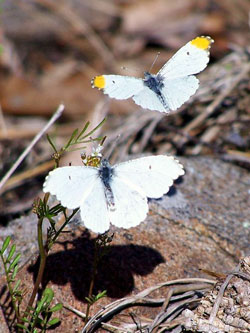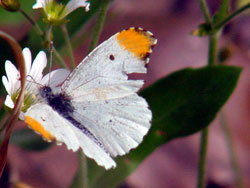Find a Butterfly
Falcate Orangetip
Anthocharis midea
Named
Hubner, 1809

Taxonomy & Nomenclature
The genus Falcapica and the species name genutia are sometimes used.
Identification
Wingspan: 1 3/8 - 1 1/2". Massachusetts‘ smallest "white" and virtually unmistakable. Males readily recognized by the bright orange tips of the forewings above, lacking or (rarely) replaced by yellow in females). In both sexes, the tips of the forewings are distinctly bent and angled outward (falcate means "hooked"). Undersides of hindwings strikingly marbled in green and yellow.
Distribution
Southeastern Nebraska and eastern Texas east to southern New England and the coastal plain of Georgia. In New England confined to the Connecticut River Valley from New Haven to Wilmington, Vermont. Though several of Scudder‘s correspondents considered the species to be common or abundant at some of its Connecticut haunts, it is decidedly local in New England today, becoming rare northward; much commoner and more widespread in the southern and western portions of its range.
Status in Massachusetts
The only recent record for the state is a sight record by an experienced observer from Tannery Falls, Savoy (Berkshire Co.) 26 May 1992, (T. Simmons). The only other Massachusetts record is from Scudder (1889): "seen upon similar trap hills in the vicinity of Holyoke, Mass" (no year given). Not found during the atlas period (1986-90) despite diligent searching of areas in the Connecticut Valley where its food plant grows. None of the areas checked seem as suitable as the current Connecticut breeding localities. A sight record in 1986 by a non-lepidopterist of "a little white butterfly with orange tips on the wings" at Holyoke Cove, may well have been this species. Given current stations in Vermont and Connecticut and previous records for Massachusetts, it is plausible that more thorough exploration of the highlands of western Massachusetts will yet turn up a viable population of this exquisite little butterfly in the Commonwealth.

Flight Period in Massachusetts
A single early spring flight. In Connecticut, flies from mid March to the third week in May (mainly April 15-May 15).
Larval Food Plants
Reported as feeding on a wide variety of mustards (Cruciferae) throughout its range, including Bitter Cress (Cardamine, spp.), Winter Cress (Barbarea vulgaris), and toothworts (Dentaria spp.) though some of these records are in doubt. In New England, it apparently feeds exclusively on rock cresses (Arabis, spp.), several species of which occur on basaltic outcrops including the trap rock ridges that rise above both banks of the Connecticut River. Several of these cresses are themselves listed as state threatened or endangered.
Adult Food sources
Early flowering mustards,including food plants; also violets and chickweed.

Habitat
In the center of its range, Falcate Orangetip prefers rich deciduous woodlands and mixed pine-oak woods. Clark and Clark (1951) cite a preference (in Virginia) for low areas "with large, rough-barked trees near streams or swamps" and "damp ravines and valley bottoms" in the mountains. As it ranges northward, the species becomes increasingly narrow in its habitat preference ultimately restricting itself to relatively open trap rock (basaltic) ridges.
Life Cycle
EGG: Bright orange and spindle-shaped; hatches in 4-8 days (Scudder). OVIPOSITION: The eggs typically are deposited at the base of the flower heads of the food plants, one egg per plant. LARVA: The mature larva is 3/4" long, green with numerous fine stripes in yellow, white and blue and is covered in fine downy hairs; it feeds on the flowers, buds and young seed pods of the host plant and pupates following the fourth instar in about 15 days. CHRYSALIS: Greenish yellow heavily mottled with black and purple; notably narrow and pointed at both ends and is attached to a woody stem near the host plant. PUPATION: On the trunk of a tree or elsewhere near the food plant, attached by a silken girdle and secured at the bottom by a silk "button". OVERWINTERING STAGE: Chrysalis; in unfavorable seasons, chrysalis persists until the following spring.
This is one of the earliest-emerging butterflies in the Northeast, adults appearing well before the last frosts and before the trees have leafed out. They are active on cloudy days and in shade, seeking warmth when necessary along open ridge tops and south facing slopes. Males search for mates within a restricted home range, but mark and recapture studies indicate that females leave their natal area and never return. Pairs engage in brief courtship flights, spiraling upward to twenty feet or more. Mated individuals may remain in copula overnight (as long as 12 hours), possibly a selective advantage for cold weather species with short flight periods.
Account Author
Chris Leahy



